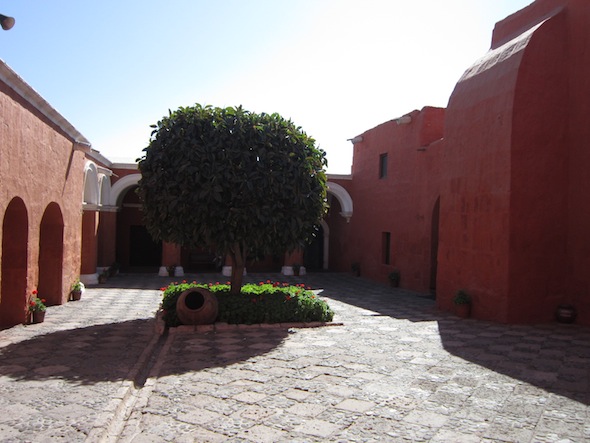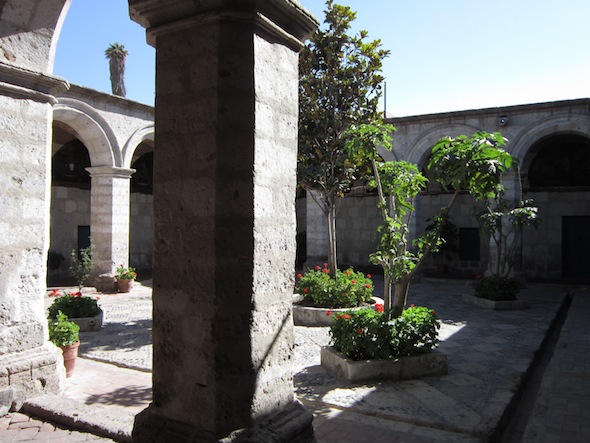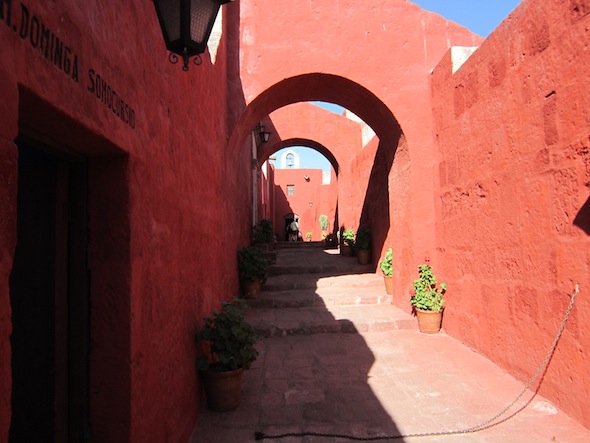Skip to...
With a strong and historic affiliation to the Catholic Church, Peru has a vast number of well-maintained Catholic buildings across the country. One of the finest examples of these constructions is the Santa Catalina Monastery in Arequipa, a fully functioning convent that is open to the public.
History of the Santa Catalina Monastery
The Santa Catalina Monastery was founded in 1579 by Maria de Guzman, a young but wealthy widow who was born in Arequipa in around 1540. From its conception, the convent was an exclusive club, with only nuns from the wealthiest families able to afford the 2,400 silver coins’ dowry, almost £100,000 today. Upon enrollment into the monastery, each nun was entitled to her own quarters and servant.
During the 17th century, Santa Catalina was enlarged to cover an area of nearly 30,000 meters squared and, at its peak, the convent housed around 150 nuns and 300 servants. However, the monastery fell on hard times in the late 1800s when Pope Pius IX reformed Santa Catalina, sending away wealthy European nuns and freeing all slaves and servants.
The monastery suffered structural damage in the 1960s when two powerful earthquakes hit Arequipa. To help pay for restoration work, and the cost of installing the electricity and running water required by civic law, the 20 nuns remaining in the convent elected to open Santa Catalina up to the public in the 1970s.

Inside the Monastery
Despite being blocked off from the city outside by high, white-stone walls, the expansion that took place on Santa Catalina during the 17th century transformed the convent into something akin to a village. Inside is a system of narrow streets, lined with pale red buildings that make the desert sky above appear a particularly vivid blue on a clear day. The stone paved alleys lead to various garden plazas, passing by side streets and open air chambers along the way.
Although a Catholic establishment, much of the architecture of Santa Catalina is Mudejar, a reinvention of European design with strong muslim Moorish influences. The most obvious example of this is the looming, white church situated within the convent.
Built from sillar, a white volcanic rock from which Arequipa takes its moniker The White City, the church is visible from many areas inside the complex, while from outside, the silhouette of the structure’s broad domed roof gives the skyline a definite Middle Eastern appearance. There are other clues of the Mudejar architecture in Santa Catalina too, such as the decorative tiling and elaborate roof work of the beautifully maintained Cloisters of the Orange Trees.
The only part of the monastery that isn’t open to the public is the northern corner, the area in which the nuns of Santa Catalina reside. However, the laundry area, comprised of an inventive system of stone basins fed by water running down a sloped gutter, the vegetable garden and adjoining kitchen, all still used by the nuns today, are accessible.

Visiting the Santa Catalina Monastery
Santa Catalina Monastery is located on Santa Catalina road around two blocks from the Plaza de Armas of Arequipa. On Tuesdays, Wednesdays, and Thursdays, the monastery is open from 8am until 8pm. The rest of the week, doors open at 9am and close at 5pm. However, during the high season, between May and November, Santa Catalina opens an hour earlier.
General admission for tourists is priced at S/.35, a fee that includes a map handed to you on entry. There is the option of a guided tour for an additional cost. Inside the monastery there are toilets, a gift shop and a picturesque outdoor cafe.

About the Author
Andreas Ambarchian is a freelance journalist from England. He writes about a variety of subjects including travel, wildlife and sport. This article was written on behalf of Peru for Less. Photos courtesy of the author.
Featured image via Unsplash.

